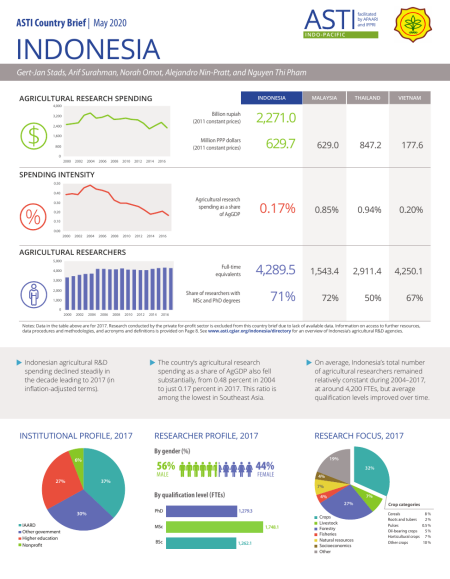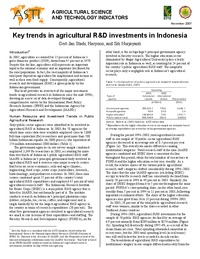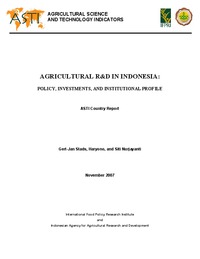Authors:
Gert-Jan Stads, Arif Surahman, Norah Omot, Alejandro Nin-Pratt, and Nguyen Thi Pham
Year:
2020
Publisher
International Food Policy Research Institute, Asia-Pacific Association of Agricultural Research Institutions, and Indonesian Agency for Agricultural Research and Development.
Back to:
The Indonesia country brief presents key agricultural R&D indicators in a highly accessible visual display. The brief also features more in-depth analysis of some of the key challenges that the country’s agricultural R&D systems are facing, and the policy options to address these challenges. It presents various future agricultural research investment scenarios and how these are projected to affect agricultural productivity growth.
Authors:
Stads, Gert-Jan; Haryono; Nurjayanti, Siti
Year:
2007
Publisher
International Food Policy Research Institute (IFPRI); and Indonesian Agency for Agricultural Research and Development (IAARD)
Back to:
In 2005, agriculture accounted for 15 percent of Indonesia’s gross domestic product (GDP), down from 45 percent in 1970. Despite this decline, agriculture still represents an important input to the national economy and an important livelihood for the rural population. In fact, the vast majority of Indonesia’s rural poor depend on agriculture for employment and income as well as their own food supply. Consequently, agricultural research and development (R&D) is given priority by the Indonesian government.
Authors:
Stads, Gert-Jan; Haryono; Nurjayanti, Siti
Year:
2007
Publisher
International Food Policy Research Institute (IFPRI); and Indonesian Agency for Agricultural Research and Development (IAARD)
Back to:
Indonesia’s total number of agricultural researchers in Indonesia fell slightly during 1994–2003 due to major reorganizations in government-led agricultural R&D. Nevertheless, with close to 5,000 fte researchers in 2003, Indonesia has one of the largest agricultural research systems in Asia. Despite the decline in researcher totals, qualifications of Indonesian agricultural research staff improved steadily in recent years, principally due to donor-financed training programs. Due to the Asian financial crisis, agricultural R&D spending has been severely cut since 1997.



